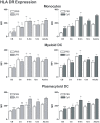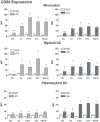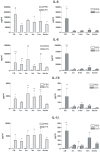Acquisition of adult-like TLR4 and TLR9 responses during the first year of life
- PMID: 20442853
- PMCID: PMC2861003
- DOI: 10.1371/journal.pone.0010407
Acquisition of adult-like TLR4 and TLR9 responses during the first year of life
Abstract
Background: Characteristics of the human neonatal immune system are thought to be responsible for heightened susceptibility to infectious pathogens and poor responses to vaccine antigens. Using cord blood as a source of immune cells, many reports indicate that the response of neonatal monocytes and dendritic cells (DC) to Toll-like receptor (TLR) agonists differs significantly from that of adult cells. Herein, we analyzed the evolution of these responses within the first year of life.
Methodology/principal findings: Blood samples from children (0, 3, 6, 9, 12 month old) and healthy adults were stimulated ex vivo with bacterial lipopolysaccharide (LPS, TLR4 agonist) or CpG oligonucleotides (TLR9 agonist). We determined phenotypic maturation of monocytes, myeloid (m) and plasmacytoid (p) DC and production of cytokines in the culture supernatants. We observed that surface expression of CD80 and HLA-DR reaches adult levels within the first 3 months of life for mDCs and 6-9 months of life for monocytes and pDCs. In response to LPS, production of TNF-alpha, IP-10 and IL-12p70 reached adult levels between 6-9 months of life. In response to CpG stimulation, production of type I IFN-dependent chemokines (IP-10 and CXCL9) gradually increased with age but was still limited in 1-year old infants as compared to adult controls. Finally, cord blood samples stimulated with CpG ODN produced large amounts of IL-6, IL-8, IL-1beta and IL-10, a situation that was not observed for 3 month-old infants.
Conclusions: The first year of life represents a critical period during which adult-like levels of TLR responses are reached for most but not all cytokine responses.
Conflict of interest statement
Figures





Similar articles
-
Toll-like receptor ligands modulate dendritic cells to augment cytomegalovirus- and HIV-1-specific T cell responses.J Immunol. 2003 Oct 15;171(8):4320-8. doi: 10.4049/jimmunol.171.8.4320. J Immunol. 2003. PMID: 14530357
-
Toll-like receptor expression reveals CpG DNA as a unique microbial stimulus for plasmacytoid dendritic cells which synergizes with CD40 ligand to induce high amounts of IL-12.Eur J Immunol. 2001 Oct;31(10):3026-37. doi: 10.1002/1521-4141(2001010)31:10<3026::aid-immu3026>3.0.co;2-h. Eur J Immunol. 2001. PMID: 11592079
-
Zymosan Induces Immune Responses Comparable with Those of Adults in Monocytes, Dendritic Cells, and Monocyte-Derived Dendritic Cells from Cord Blood.J Pediatr. 2015 Jul;167(1):155-62.e1-2. doi: 10.1016/j.jpeds.2015.03.035. Epub 2015 May 7. J Pediatr. 2015. PMID: 25957979
-
Ontogeny of Toll-like receptor mediated cytokine responses of human blood mononuclear cells.PLoS One. 2010 Nov 30;5(11):e15041. doi: 10.1371/journal.pone.0015041. PLoS One. 2010. PMID: 21152080 Free PMC article.
-
IL-12p70-dependent Th1 induction by human B cells requires combined activation with CD40 ligand and CpG DNA.J Immunol. 2004 Jan 15;172(2):954-63. doi: 10.4049/jimmunol.172.2.954. J Immunol. 2004. PMID: 14707068
Cited by
-
Bovine Neonatal Monocytes Display Phenotypic Differences Compared With Adults After Challenge With the Infectious Abortifacient Agent Neospora caninum.Front Immunol. 2018 Dec 19;9:3011. doi: 10.3389/fimmu.2018.03011. eCollection 2018. Front Immunol. 2018. PMID: 30619358 Free PMC article.
-
Role of milk carbohydrates in intestinal health of nursery pigs: a review.J Anim Sci Biotechnol. 2022 Jan 5;13(1):6. doi: 10.1186/s40104-021-00650-7. J Anim Sci Biotechnol. 2022. PMID: 34983676 Free PMC article. Review.
-
TLR agonist combinations that stimulate Th type I polarizing responses from human neonates.Innate Immun. 2018 May;24(4):240-251. doi: 10.1177/1753425918771178. Epub 2018 Apr 19. Innate Immun. 2018. PMID: 29673285 Free PMC article.
-
Increasing JAK/STAT Signaling Function of Infant CD4+ T Cells during the First Year of Life.Front Pediatr. 2017 Feb 21;5:15. doi: 10.3389/fped.2017.00015. eCollection 2017. Front Pediatr. 2017. PMID: 28271056 Free PMC article.
-
Maternal imprinting and determinants of neonates' immune function in the SEPAGES mother-child cohort.Front Immunol. 2023 Apr 4;14:1136749. doi: 10.3389/fimmu.2023.1136749. eCollection 2023. Front Immunol. 2023. PMID: 37081891 Free PMC article.
References
-
- Siegrist CA. Vaccination in the neonatal period and early infancy. Int Rev Immunol. 2000;19:195–219. - PubMed
-
- Wilson CB, Lewis DB. Basis and implications of selectively diminished cytokine production in neonatal susceptibility to infection. Rev Infect Dis. 1990;12(Suppl 4):S410–20: S410–S420. - PubMed
-
- Adkins B, Leclerc C, Marshall-Clarke S. Neonatal adaptive immunity comes of age. Nat Rev Immunol. 2004;4:553–564. - PubMed
-
- Levy O. Innate immunity of the newborn: basic mechanisms and clinical correlates. Nat Rev Immunol. 2007;7:379–390. - PubMed
Publication types
MeSH terms
Substances
LinkOut - more resources
Full Text Sources
Medical
Research Materials

